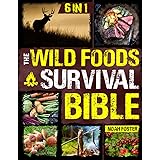Woodland Plants for Winter Survival: Essential Resources for Cold Weather Foraging
As temperatures plummet to near-unfathomable lows, such as the 3 to 5 degrees Fahrenheit experienced by many outdoor enthusiasts, the wilderness can seem stark and unforgiving. Yet, even in the depths of winter, nature provides an abundance of critical resources for those who possess the knowledge to find and utilize them. The video above offers a compelling glimpse into the resilience of woodland plants for winter survival, highlighting several key species and their remarkable properties. This accompanying guide delves deeper into these vital resources, expanding on their benefits for food, medicine, fire, and water in challenging cold-weather conditions.
Navigating the Winter Landscape for Vital Resources
Successful winter foraging demands not only plant identification skills but also an understanding of the environment. The speaker in the video aptly demonstrates how recognizing topographical features, such as high and low spots, can reveal where specific resources are likely to thrive. Low-lying areas, for instance, often retain more moisture, influencing plant growth and the availability of certain tinder materials.
Furthermore, an appreciation for the subtle signs of the season is paramount. While snow and ice might cover much of the ground, persistent structures like dried stalks or evergreen foliage remain visible. Understanding the life cycles of plants and their seasonal changes empowers foragers to pinpoint edibles and medicinals even when they appear dormant. Therefore, keen observation and foundational botanical knowledge are indispensable for anyone venturing into the winter woods.
Edible & Medicinal Treasures Among Woodland Plants for Winter Survival
The winter woodland, despite its barren appearance, harbors numerous plants that can provide sustenance and alleviate ailments. Each of these species holds a unique place in the survivalist’s toolkit.
Basswood Buds: Soothing & Sustaining
Even when frozen solid, basswood buds offer a surprisingly palatable and beneficial resource. These small, nutrient-dense buds are not merely an emergency food source; they possess notable medicinal qualities. Particularly effective for a sore throat, basswood buds can help soothe irritation often associated with winter colds and flu. Their mucilaginous properties, though not explicitly detailed in the video, are largely responsible for this comforting effect, creating a protective layer in the throat. Consequently, identifying basswood (Tilia americana) is a valuable skill for both sustenance and natural relief during the colder months.
Conifer Needles: A Vitamin C Powerhouse
Among the most accessible winter resources are the needles of conifers, specifically white pine (Pinus strobus) and spruce (Picea spp.). These needles are celebrated for their exceptionally high vitamin C content, a crucial nutrient for bolstering the immune system and combating scurvy, especially when fresh produce is scarce. The speaker wisely advises against boiling pine or spruce needles, as high heat rapidly degrades vitamin C. Instead, steeping them in cold or warm water for tea, or simply chewing them fresh, preserves this vital nutrient. While spruce may have a stronger, more resinous taste reminiscent of turpentine, both offer significant health benefits. The preference for white pine, as noted, is often due to its milder flavor profile, making it a more palatable choice for direct consumption.
Cottonwood & Willow: Nature’s Aspirin
The cottonwood tree (Populus spp.), a member of the diverse willow family (Salicaceae), presents another remarkable winter resource. Its buds, particularly as they swell in late winter, are rich in a sticky, aromatic resin, often referred to as “Balm of Gilead.” This balm is renowned for its anti-inflammatory and analgesic properties, making it an excellent topical application for sore joints, arthritis, and aching muscles. Beyond topical use, both cottonwood buds and the inner bark of all willow species contain salicin, a compound chemically similar to aspirin (acetylsalicylic acid). Consuming these parts can effectively reduce aches, pains, and fevers, offering a natural and widely available alternative to synthetic medications in the wilderness. However, it is always prudent to be aware of potential sensitivities, especially for those who react to aspirin.
Oak Bark: Antiseptic & Astringent
The mighty oak, whether white oak (Quercus alba), red oak (Quercus rubra), or indeed most local oak species, holds a significant place in natural medicine, particularly its inner bark. This part of the tree is rich in tannins, potent compounds known for their antiseptic and astringent qualities. Tannins can be extracted by steeping the inner bark in water to create a tea, which can then be used to cleanse wounds, reduce inflammation, and stop bleeding. Internally, a diluted tea may address certain digestive issues. However, the speaker rightly emphasizes caution: tannins, especially in high concentrations or with prolonged use, are considered potential carcinogens. Therefore, consultation with a professional herbalist or medical doctor is strongly advised before internal consumption to ensure safe and appropriate usage, turning a potentially harmful substance into a beneficial remedy.
Securing Water & Fire: Fundamental Survival Needs
Beyond food and medicine, the ability to obtain clean water and create fire are cornerstones of winter survival.
Maple Sap: Nature’s Sweet Hydration
In winter, finding potable water without boiling can be a critical challenge. Fortunately, certain trees offer a direct source of hydrating liquid. Maple trees (Acer spp.), identifiable by their opposite branching patterns, can be tapped for their sap when daytime temperatures rise above freezing and nighttime temperatures drop below. This natural phenomenon allows the tree to draw water and nutrients from its roots, providing a clear, pure liquid rich in natural sugars and carbohydrates. This offers not only hydration but also a valuable energy boost, crucial for maintaining body warmth and stamina in cold environments. While grapevines can also yield drinkable liquid, maple sap is generally a more reliable and abundant source, providing a life-saving alternative to boiled water in a survival scenario.
Finding Fire: Tinder & Ignition
Starting a fire in winter demands both knowledge and the right materials. The speaker demonstrates that even when everything seems damp, dry tinder is often hidden just beneath the surface. Old, fallen ash (Fraxinus spp.) and cottonwood trees, for instance, retain dry bark that can be peeled away to reveal ready-to-use tinder. Moreover, wetland plants like cattails (Typha latifolia) and especially Phragmites reeds (Phragmites australis) offer excellent tinder materials. The fluffy heads of cattails and Phragmites are highly combustible flash tinder, catching a spark with ease. The dried stalks of these plants, particularly Phragmites, then serve as ideal kindling to build a sustainable fire, even allowing for ignition of damp wood. Thus, understanding where to source these crucial components dramatically improves winter fire-starting success.
Sustaining Health and Energy in the Wilderness
Staying healthy and energized in the winter woods is a holistic endeavor. The speaker’s personal practice of regular hikes and nibbling on wild edibles underscores a proactive approach to wellness. Exposure to limited winter sunlight provides vital vitamin D, known to boost immunity and fight off sickness. Concurrently, the micronutrients derived from foraged plants like pine needles and sumac berries contribute to overall bodily strength and resilience. While sumac berries (Rhus typhina) may have some vitamin C leached out by winter rains, steeping them in cold water still extracts valuable nutrients and a flavorful, energizing drink, far superior to plain water. These intentional acts of interacting with nature, both for physical activity and nutritional intake, fortify the body against the harsh realities of winter.
Indeed, the diverse array of woodland plants for winter survival are not just resources; they are testaments to nature’s enduring provision. By cultivating the knowledge and respect for these vital species, outdoor enthusiasts can transform a potentially hostile winter environment into a landscape of opportunity and sustenance.











